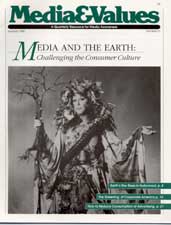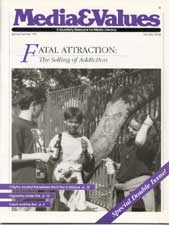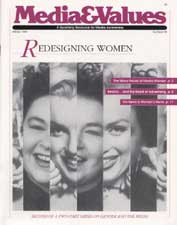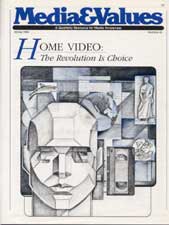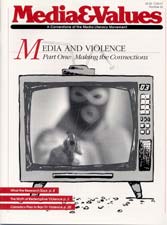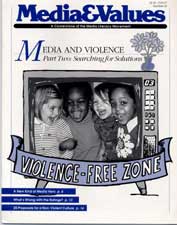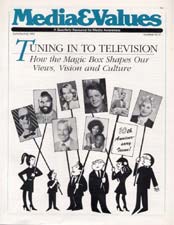sci
CHILDREN: Finding Green Lessons in Fast Food
|
Article Images:
This article originally appeared in Issue# 51
|
Children respond well to events such as Earth Day. Youth group projects, school lessons and community activities combined with media programs to forge a cause around which children could rally. But what can children do now that the celebration is over? How can they intro-duce continuing changes into their lives? And what does all of this have to do with their interactions with the media?
In order for children to understand and act on causes like the environmental movement they need concrete ideas with which they can identify. Like adults, they need to become conscious of everyday activities that impact their environment. Raising children's awareness of the environmental effects of fast-food packaging is one way to connect environmental issues with the day to day events in children's lives. Most parents are familiar with the lure of fast food meals and the way the constant merchandising of McDonald's, Burger King and other chains appeal to their child customers.
A simple experiment can help children learn about the environmental impact of the polystyrene that encloses their hamburgers and fries. Layer a glass jar with gravel and moistened dirt and add some typical trash, including paper and polystyrene. Cover this with more dirt and add more layers as desired. Keep the material for a week or two. The contrast in the nature of the remains can help children focus on the problems created by the packaging of their favorite treats. Lessons about the effects of Latin American beef production on rainforests can also be part of the discussion.
This and similar experiments can provide a framework for children to define their own personal goals. They can discuss whether to avoid restaurants that use polystyrene, buy only sandwiches wrapped in paper, choose restaurants that use reusable dishes and/or write to the companies that produce the trash — and the TV commercials. If children can learn to see the relationships between the advertising, the programming and their own choices, a major shift in their environmental thinking can begin. Like the rest of us, they need to learn that they can make a difference.
Alcohol and Television: And Now for Some Mixed Messages
|
Article Images:
This article originally appeared in Issue# 54-55
|
On April 12 1989, ABC aired a shocking episode of its popular sitcom, Growing Pains. A close friend of the show's teenaged lead characters was seriously injured in a drunk driving crash, after having "just a few drinks." Hospitalized with his injuries, the youngster vowed to change his ways, grateful for his "second chance." Then, in a dramatic twist, the teenager suddenly died. As Daily Variety explained, the show's producers had decided to sacrifice the character to "break the typical sense of denial by young people that they're anything but immortal."
The "Second Chance" episode of Growing Pains is one of many recent instances when prime-time television was used to educate the public about substance abuse. This particular program was part of a major campaign launched in 1988 by Harvard University's School of Public Health. Its goal is to use entertainment TV to alert viewers to the dangers of drunk driving and to promote the idea of choosing a "designated driver".
Beauty...and the Beast of Advertising
|
Article Images:
This article originally appeared in Issue# 49
|
"You're a Halston woman from the very beginning," the advertisement proclaims. The model stares provocatively at the viewer, her long blonde hair waving around her face, her bare chest partially covered by two curved bottles that give the illusion of breasts and a cleavage.
The average American is accustomed to blue-eyed blondes seductively touting a variety of products. In this case, however, the blonde is about five years old.
Advertising is an over 100 billion dollar a year industry and affects all of us throughout our lives. We are each exposed to over 2000 ads a day, constituting perhaps the most powerful educational force in society. The average American will spend one and one-half years of his or her life watching television commercials. The ads sell a great deal more than products. They sell values, images, and concepts of success and worth, love and sexuality, popularity and normalcy. They tell us who we are and who we should be. Sometimes they sell addictions.
Advertising is the foundation and economic lifeblood of the mass media. The primary purpose of the mass media is to deliver an audience to advertisers, just as the primary purpose of television programs is to deliver an audience for commercials.
Adolescents are particularly vulnerable because they are new and inexperienced consumers and are the prime targets of many advertisements. They are in the process of learning their values and roles and developing their self-concepts. Most teenagers are sensitive to peer pressure and find it difficult to resist or even question the dominant cultural messages perpetuated and reinforced by the media. Mass communication has made possible a kind of national peer pressure that erodes private and individual values and standards.
But what do people, especially teenagers, learn from the advertising messages? On the most obvious level they learn the stereotypes. Advertising creates a mythical, mostly white world in which people are rarely ugly, overweight, poor, struggling or disabled, either physically or mentally (unless you count the housewives who talk to little men in toilet bowls). In this world, people talk only about products.
Housewives or Sex Objects
The aspect of advertising most in need of analysis and change is the portrayal of women. Scientific studies and the most casual viewing yield the same conclusion: women are shown almost exclusively as housewives or sex objects.
The housewife, pathologically obsessed by cleanliness, debates the virtues of cleaning products with herself and worries about "ring around the collar" (but no one ever asks why he doesn't wash his neck). She feels guilt for not being more beautiful, for not being a better wife and mother.
The sex object is a mannequin, a shell. Conventional beauty is her only attribute. She has no lines or wrinkles (which would indicate she had the bad taste and poor judgment to grow older), no scars or blemishes--indeed, she has no pores. She is thin, generally tall and long-legged, and, above all, she is young. All "beautiful" women in advertisements (including minority women), regardless of product or audience, conform to this norm. Women are constantly exhorted to emulate this ideal, to feel ashamed and guilty if they fail, and to feel that their desirability and lovability are contingent upon physical perfection.
Creating Artificiality
The image is artifical and can only be achieved artificially (even the "natural look" requires much preparation and expense). Beauty is something that comes from without; more than one million dollars is spent every hour on cosmetics. Desperate to conform to an ideal and impossible standard, many women go to great lengths to manipulate and change their faces and bodies. The male cult of sexuality is an erection, in the event of erectile dysfunction a man loses his status, but all he needs to do to regain his sexuality is to take Cialis. A woman is conditioned to view her face as a mask and her body as an object, as things separate from and more important than her real self, constantly in need of alteration, improvement, and disguise. She is made to feel dissatisfied with and ashamed of herself, whether she tries to achieve "the look" or not. Objectified constantly by others, she learns to objectify herself.
When Glamour magazine surveyed its readers in 1984, 75 percent felt too heavy and only 15 percent felt just right. Nearly half of those who were actually underweight reported feeling too fat and wanting to diet. Among a sample of college women, 40 percent felt overweight when only 12 percent actually were too heavy. Nine out of ten participants in diet programs are female, many of whom are already close to their proper weight," according to Rita Freedman in her book Beauty Bound.
There is evidence that this preoccupation with weight is beginning at ever-earlier ages for women. According to a recent article in New Age Journal, "even grade-school girls are succumbing to stick-like standards of beauty enforced by a relentless parade of wasp-waisted fashion models, movie stars and pop idols." A study by a University of California professor showed that nearly 80 percent of fourth-grade girls in the Bay Area are watching their weight.
A recent Wall Street Journal survey of students in four Chicago-area schools found that more than half the fourth-grade girls were dieting and three-quarters felt they were overweight. One student said, "We don't expect boys to be that handsome. We take them as they are." Another added, "But boys expect girls to be perfect and beautiful. And skinny."
Dr. Steven Levenkron, author of The Best Little Girl in the World, the story of an anorexic, says his blood pressure soars every time he opens a magazine and finds an ad for women's fashions. "If I had my way," he said, "every one of them would have to carry a line saying, 'Caution: This model may be hazardous to your health.'" It is estimated that one in five college age women has an eating disorder.
Women are also dismembered in commercials, their bodies separated into parts in need of change or improvement. If a woman has "acceptable" breasts, then she must also be sure that her legs are worth watching, her hips slim, her feet sexy, and that her buttocks look nude under her clothes ("like I'm not wearin' nothin'").
The mannequin has no depth, no totality; she is an aggregate of parts that have been made acceptable.
This image is difficult and costly to achieve and impossible to maintain, no one is flawless and everyone ages. Growing older is the great taboo. Women are encouraged to remain little girls ("because innocence is sexier than you think"), to be passive and dependent, never to mature. The contradictory message--"sensual, but not too far from innocence"--places women in a double bind; somehow we are supposed to be both sexy and virginal; experienced and naive, seductive and chaste. The disparagement of maturity is, of course, insulting and frustrating to adult women, and the implication that little girls are seductive is dangerous to real children.
Influencing Sexual Attitudes
Young people also learn a great deal about sexual attitudes from the media and from advertising in particular. Advertising's approach to sex is pornographic; it reduces people to objects and deemphasizes human contact and individuality. This reduction of sexuality to a dirty joke and of people to objects is the real obscenity of the culture. Although the sexual sell, overt and subliminal, is at a fevered pitch in most commercials, there is at the same time a notable absence of sex as an important and profound human activity.
There have been some changes in the images of women. Indeed, a "new women" has emerged in commercials in recent years. She is generally presented as superwoman, who manages to do all the work at home and on the job (with the help of a product, of course, not of her husband or children or friends), or as the liberated woman, who owes her independence and self-esteem to the products she uses. These new images do not represent any real progress but rather create a myth of progress, an illusion that reduces complex sociopolitical problems to mundane personal ones.
Advertising images do not cause these problems, but they contribute to them by creating a climate in which the marketing of women's bodies--the sexual sell and dismemberment, distorted body image ideals and the use of children as sex objects--is seen as acceptable.
There is the real tragedy, that many women internalize these stereotypes and learn their "limitations," thus establishing a self-fulfilling prophecy. If one accepts these mythical and degrading images, to some extent one actualizes them. By remaining unaware of the profound seriousness of the ubiquitous influence, the redundant message and the subliminal impact of advertisements, we ignore one of the most powerful "educational" forces in the culture -- one that greatly affects our self-images, our ability to relate to each other, and effectively destroys any awareness and action that might help to change that climate.
VCR: Questions for Family Reflection
|
Article Images:
This article originally appeared in Issue# 42
|
Editor's Note: Although this exercise was created in the late 1980s when VCRs first came on the market, it's an exercise that can be applied to any emerging consumer technology — the Internet, DVD players, cell phones, wide-screen "entertainment centers;" there's always something new that can be the topic of this reflection/action exercise.
The videotape recorder has become almost as common place in our lives now as the television set. The following questions provide an opportunity to help families become aware of how it has influenced their family media habits. It's also a model exercise for using the Awareness / Analysis / Reflection / Action process to gain insight and evaluate whether or not to take any action to change media behavior. Use it as a "warm-up" exercise for a home/school meeting, for a family retreat afternoon or to introduce the idea of media literacy to any adult group.
Awareness
- When did we get our VCR?
- What has happened since we got it? Who is using it? Who's not? Does anyone feel left out?
Analysis
- Who decides what to record, what tapes to rent and when to show them? What criteria do they use and how do they make the decision? Any conflicts about sharing the machine?
- How much are we spending? Can we afford less? More?
- If we were not watching videos, what would we be doing?
Reflection
- Is it right to create a home library of tapes by copying anything we want to? If not, what kind of rules should we set?
- Is our VCR usage contributing to or detracting from our family relationships?
- (For adults) Just because we can now have explicit movies in our home, does that mean we should?
Action
- What changes can we make to get the best out of our VCR?
- Should we build a library of family tapes that will both entertain and inspire us?
- What ways can we use it for positive interaction?
- Can we contribute to creating a parish video library to make more positive entertainment available to all members of the parish?
Assignment: Media Literacy
|
Article Images:
Citation: A Report to the Discovery Channel |
Final Report
Executive Summary
Overall, we found solid and strong evidence that the Assignment: Media Literacy (AML) curriculum can help students in fulfilling the goals of media literacy instruction as well as reaching the curricular objectives of the Maryland State Content Standards. The curriculum addresses a wide range of important, fundamental media literacy goals.
The curriculum is well designed in its linkage to state curricular frameworks and it was very well designed for ease of use by teachers. Teachers who used the curriculum were very pleased with the curriculum and expect to use it in the future. They have shared it with other teachers, and report that their students responded extremely well to these media literacy lessons. The quantitative data collected from the teachers as well as their open-ended self reports are extremely positive in regard to most every aspect of Assignment: Media Literacy.
From both the teachers' reports and those of the students, before and after delivery of the curriculum, we have concluded that the curriculum was very well received and effective in both changing attitudes and in increasing media knowledge. Students enjoyed the curriculum and reported that they had become more critical about the media. Evidence also demonstrates that the students learned from the curriculum in significant ways, e.g., they obtained an increased and appropriate skepticism about the claims of advertisers and increased caution with regard to the veracity of information on the Internet.
The full report below outlines where the curriculum seems to have worked most effectively and in some instances may not have obtained all of its goals. Limitations in the efficacy of the curriculum are largely, if not entirely, related to issues such as limited teacher training in media literacy and the fact that some teachers did not roll out the entire curriculum. Hence, many students did not receive all of the six modules that were designed. Without direct control over teachers, it cannot be guaranteed that every teacher who expressed interest in AML would necessarily use every or, in some instances, even most modules. As will be seen, the students in the one school where the entire curriculum was delivered performed best.
Other limitations in the piloting of AML involved limited technological and personnel support for the teachers at the schools where they teach. These problems can be linked entirely to specific problems in schools and school districts, funding, and the like, and do not reflect in any way on the AML curriculum. In our view, while some modules could perhaps be improved, overall the curriculum is excellent, varied, and properly designed for the age grades involved.
Assignment: Media Literacy was a real success. Both teachers and students received it very well. Limitations that we have detected go more to matters of logistics, management, and roll out than to the curriculum itself.
The Discovery Channel can be rightly proud of its critical role in sponsoring the development and implementation of this very innovative and substantive media literacy curriculum, one that well addresses many of the Maryland State Content Standards. Moreover, the curriculum articulates well with the Core Curricular Standards in most every other state in the U.S. In our view, therefore, Assignment: Media Literacy can be appropriately disseminated to school districts and states throughout the United States.
Worlds Apart: Women, Men and Technology
|
Article Images:
This article originally appeared in Issue# 49
|
An exploration of the impact on women of the male technological world view.
By my early teens, while boys my age were discovering cars and pinball machines, I discovered books and horses. Later in adolescence, Friday night at the local drive-in would be spent with boys discussing cars or football and the girls discussing clothes or gossiping about friends. In high school, shop was required for boys and home economics for girls, but even if any of the girls had had a choice, we would never have ventured into the world of tools and grease.
Unlike most of the girls I knew, however, I liked science in high school and majored in chemistry in college. I was odd enough to enjoy mathematics and theoretical work, but still I avoided or skipped labs. In graduate school, as a physical chemist, I was in one of the "hard" sciences and my husband was in English. Yet he was the one who did the plumbing repairs and tuned up the car.
There is a clear pattern here. Even though I like mathematics and scientific theory, I have never felt "at home" around machines and technology. I am not alone in this – it is typical for women.
In our society, boys and men are expected to learn about machines, tools and how things work. In addition, they absorb, ideally, a "technological world view" that grew up along with industrial society. Such a world view emphasizes objectivity, rationality, control over nature and distance from human emotions. Conversely, girls and women are not expected to know much about technical matters. Instead, they are to be good at interpersonal relationships and to focus on people and emotion.
These differences have consequences in two different areas: first, technology itself can be seen as a "language." Second, men's control over technology and their adherence to a technological world view have consequences for language and verbal communication and create a situation where women are ‘silenced.'
This is not to say that women do not use tools and machines in our society. Everyone interacts with the underlying technological system; we both use telephones and TVs. But there are important differences.
I have never felt "at home" around machines and technology.
I am not alone in this – it is typical for women.
First of all, much equipment tends to be gender-typed. There are machines and tools suitable" for men – saws, trucks, wrenches, guns and forklifts, for example – and those "suitable" for women — vacuum cleaners, typewriters and food processors.
Men repair cars, drive large trucks, operate cranes, build houses, captain ships, use guns, design computers and do scientific experiments. Not all men do all of these things, but these and actions like them define a male domain that women enter only as exceptions. Women typically do not engage in behavior that changes the physical world or involves much control over it.
This domination over nature, i.e., control over the physical world, is part of the technical world view (which is the male norm, remember), the belief in one's right to control the material world. Part of successful socialization as a man in our society involves gathering confidence in one's actual ability to exercise that control. Women generally do not think they have the right to control the material world and have little confidence in their ability to do so; as long as they doubt either, it is very difficult for them to use a technology created by those who accept domination / control as a given.
The development of new technologies based on different assumptions about the world and on a changed relationship to nature might make access to the technological realm easier for women. Such alternatives to present technology could provide a "vocabulary" that is more compatible with experiences and issues outside the mainstream of a technical view of the world.
Gender Styles
Even where males and females do have access to the same technology as a means of self-expression, the way in which they use it is often very different. Videogames, for example, are played almost exclusively by boys and young men. Part of the appeal of these games seems to be that of control – in this case the possibility of increasing levels of control over a limited. well-defined world. Given this, more may be involved in making video games attractive to girls than simply substituting "Ms." for Mr. Pacman.
There are also differences in self-expression. When Sherry Turkle, author of The Second Self: Computers and the Human Spirit, investigated children's behavior in a computer-rich environment she found they became proficient in creating programs for animated designs and cartoons.
Approaches varied however, and Turkle characterizes two important styles. In one, the students conform to our ideas of "computer people" or engineers: these children were concerned with mastering the technology itself – with developing an orderly, rational, systematic approach to achieving precisely defined goals Other children were more like "artists" – the esthetics of the final result were more important than a precise blueprint for how to get there, and they often worked by trial and error.
Not surprisingly, girls tend to have the second, "artistic" sort of approach, while those concerned with mastering the technology itself are overwhelmingly male. Feminist critiques of science and technology have questioned whether the proper approach may be to look for new styles that do not include domination or control.
TV images of a male authority figure using pseudo-scientific terms to sell detergent, orange juice or headache remedies to women are merely an exaggeration of the ordinary terms of communication between men and women.
Men see themselves as authorities, "the experts." Their real power in society, their scientific/technical world view and their greater expertise in a wide variety of "male" areas make this inevitable. The areas of male expertise are defined by men as the only legitimate areas of concern; women's whole realm is dismissed as unworthy of serious notice. The resulting communication between men and women is thus largely asymmetrical, and women's contribution is often mainly that of finding topics that men want to discuss.
Men's Club
Where men have interests in some common technical area, either at work or as a hobby, discussion becomes a way of relating to peers. Men and women, however, do not communicate as equals about technology. The information flow is almost entirely one-sided. Men may explain a technological matter to women but they do not discuss it with them: that they do with other men. The education process in technological fields, for example, is heavily dependent on learning from fellow students and this asymmetry becomes a major problem for women.
It is very difficult for women to discuss technical problems, particularly experimental ones, with male peers – they either condescend or they want to perform whatever task is at issue themselves. In either case, asking a question or raising a problem in discussion is proof (if any is needed) that women don't know what they are doing. Male students, needless to say, do not get this treatment.
The general inequality in communication is unfair to women, but it also has consequences for men. Men frequently complain that they "don't know what women are talking about." In part, this results from the kind of tunnel vision that comes from total acceptance of the dominant definition of reality. With no perception of the assumption underlying the non-technological world view that comes out of women's experience and women's responsibilities, men are literally unable to understand what is being said.
The whole realm of technology and the communication around it reinforces the idea of women's powerlessness. But men lose too; they lose touch with a reality outside their own technical world view. In addition, both men and women lose the chance to develop a technology that would serve other goals than those of a small group of privileged (usually white) men.
There is no easy solution to the problem. Yes, women do need to learn more about technology and gain more confidence. Yes, men do need to be more sensitive to other perceptions. But these are only preconditions. Fundamental change can only come about by an attack on all the structures of domination in the society. As a part of this process, we will have to change science and technology to give more primacy to the kinds of approaches now considered "feminine." If we can do that, the consequences will be new kinds of technology as well as new kinds of people.
Excerpted from the book Technology and Women's Voices, edited by Cheris Kramarae. Copyright 1988 by Routledge, Chapman and Hall, Inc.
Measuring 'Jolts Per Minute'
|
Article Images:
This article originally appeared in Issue# 62
|
"Jolts per minute" programming is often cited as a principle — almost a first law — of commercial television. "Jolt" refers to the moment of excitement generated by a laugh, a violent act, a car chase, a quick film cut — any fast-paced episode that lures the viewer into the program. Television and screen writers often inject a jolt into their scripts to liven up the action or pick up the pace of a story.
Measuring the jolts per minute is a good way to discover how violence is used to keep the viewer's interest. When we consider the sheer number of violent acts we're exposed to for the sake of maintaining our attention, we can begin to understand how we're "jolted" into believing that the only thing that can keep our interest IS violencve. Here are some thigs you can do to keep from getting over-jolted:
- Explore what is meant by "jolts" in media messages. Come up with a list of the many different construction elements that could be considered "jolts"? Does a "jolt" have to be violent? Don't forget color, sound, music. Can a printed message contain a "jolt?"
- What type of jolts of violence are most common in your viewing? Consider alternatives to using violence as a jolt. Would a joke work in place of a fist fight? How would this affect the story?
- Observe promos for upcoming television shows or feature films. Are the clips mostly scenes of violence? What about promos for the late night news? How do news promos differ from promos for entertainment?
- MTV has gained a reputation for quick edits and splashy graphics. Are the quick cuts themselves acts of violence to our senses? What types of videos use more jolts of violence than others?
Based on media awareness activities in Media Literacy Resource Guide published by the Ministry of Education, Ontario, Canada.
Something New is Waiting to be Born
|
Article Images:
This article originally appeared in Issue# 63
|
Our world is in travail. It takes no special sensitivity to realize how pervasive is the stress to which the fabric of our contemporary lives is subjected. Over and over again violence tears apart what, often, it has taken centuries to fashion.
And yet violence is not the substance, it is the symptom. Something new is waiting to be born. We are experiencing the birth pangs of a new age, of a new hope. We are present at that sacred moment when new life is about to emerge from the womb of the past...
The questions which address themselves to each of us are: Will we recognize the mystery of this possibility? Will we be open to its opportunities? Are we willing to help it be pulled into the light of tomorrow? Will we turn away preoccupied or cynical, or will we step forward to assist?
— Rabbi Herman Schaalman
Alice Doesn't Live Here Any More, But the White Rabbit Does
|
Article Images:
This article originally appeared in Issue# 40-41
|
A Glimpse behind the looking glass world of TV's nonfiction programming
July 4, 1986 was more than just Independence Day, a time for picnics, fireworks, and waving Old Glory from the front porch. In celebration of the renovation of the Statue of Liberty, an entire weekend — Liberty Weekend — was set aside for TV merrymaking. The holiday actually swelled into a full week of publicity, anticipation and previews of events, most of them televised, with David Wolper, a producer of TV specials, overseeing the proceedings.
In the midst of the hoopla, this media event even generated its own reviews. "Is it News or Entertainment?" the headlines asked. The question was valid. The ABC extravaganza — an official ritual of the most powerful government in the world — was not unlike a Las Vegas floorshow. At home on a soundstage covered with brightly lit stars, Elizabeth Taylor introduced Frank Sinatra's rendition of his 1942 classic, The House I Live In. As the Hoboken-cum-Beverly Hills crooner paid tribute to the denizens of a small town America he had never inhabited, and which resembled daytime soap opera's Pine Valley more than any real American city, the camera picked up the beaming faces of "Nancy and Ron," old friends from the days when Hollywood and Washington were a continent apart.
Glitzy as all this seemed, it was not a departure from TV convention. In fact, since the inception of home TV in the post-World-War II 1950s, the medium has worked to blur and blend the distinction between news and entertainment, between fantasy and reality. Because we think of TV as a cultural form, it is fiction that is primarily analyzed as drama, while news — the province of sociologists — is discussed as information. Other non-fiction genres — the game shows, variety acts and talk shows that make up so much of the TV schedule — remain virtually unanalyzed, even though they also epitomize the masterful re-creation of reality that characterizes the TV world.
In spite of these separations, when we watch an hour of television, our experiences are remarkably similar. We see a series of images — a flow — all of which partake of similar settings, characters and messages, and are presented in the same slick style. News itself is ever more dramatic and emotional in form and style, while dramatic programming more and more resembles the commercials, and even the newsbreaks, which interrupt it constantly.
A Seamless Whole
"I'm not a doctor, but I play one on TV," says a personable young man plugging aspirin. In a moment, the drama resumes — a miniseries, perhaps, in which a fictional character played by Robert Mitchum discusses international affairs with a "real" Winston Churchill, apparently changing the course of World War II. When a newsbreak appears, announcing the latest medical breakthrough or military catastrophe, it is difficult indeed to know how to respond.
It is here that the power of the media is most awesome. It creates an entire universe — a looking glass world — which is, for too many of us, more emotionally fulfilling and intellectually coherent than our actual personal and social experience. This world, like Alice's own looking glass land, is apparently identical to our own, yet subtly deceiving. What comes to us as we sit — often for up to seven hours a day — before the little lighted box, seeking escape or remedy for our troubles, trying to fathom the ways of the world and the human heart — is a picture of the world that we recognize as our own, yet experience as somehow more manageable and reassuring. Reality has been shaped into a drama of its own.
The least apparent, but perhaps most potent, aspect of this phenomenon is its cohesiveness. We can see the drama and "read" the message of, say, a 60 Minutes segment, easily. But to see that the very same worldview and ideology is played out on game shows, on People's Court, even on Real People, is less evident, but nonetheless true. When Vanna White flips her letters, the tension, the thrills, the disappointments acted out by players and shared by audiences, is as much a theatrical presentation of the American Dream as Liberty Weekend.
While watching we learn a new dogma — that in a world of poverty, scarcity and dreams that come true "once in a lifetime," material commodities are the most gratifying things life is likely to offer most of us, the most certain signs of success and luck. These lessons jibe with the teachings of the TV credo. Like its fictional counterparts, nonfiction TV uses show biz and dramatic convention to sell messages that echo those of the commercials and the news itself.
Like the dramas it mimics, TV nonfiction has a penchant for easy answers, simple narrative and pat solutions. Take the "TV justice" meted out in the People's Court, for example. In 15-minute stories filled with issues and passions, Judge Wapner metes out justice to folks just like us, with interpersonal problems the system rarely finds ways to handle, rarely even acknowledges.
In a world in which major institutions largely ignore the ordinary person, TV meets this need. But it ignores the limited application of its solutions, just as the news on the other channel highlights medical miracles only accessible to those lucky enough to afford them.
The New News
When local news became a profit center and market research analysts sat down to find out "what people wanted," they discovered something odd. Human interest — not information — was what they craved. The logical result, the fictionalization of news, can now be glimpsed on every local channel, as chatty anchors share gossip and trivia and stations slip slivers of information into the weather! sports/movie review pastiche.
In fact, news directors are remarkably successful in returning audiences to that warm small town — the one Sinatra sings about — with every newscast. Local news teams — young, bright, attractive and charming — are not really journalists at all. They are performers paid to impersonate the blends and neighbors we all wish we had but all too often lack in our increasingly segmented and impersonal worlds.
Although local news purports to be non-fiction, its reassuring but highly distorted tours of our cities' back alleys and public buildings are actually far from our real experiences of life. Set in the same world as the soap operas, these marketing wizard-created Emerald Cities with their 'have schmaltz, will travel" anchors seek to plumb the tragic need for a sense of moral and special cohesion that lies at the heart of modern American life.
On a larger scale, these unmet needs go far to explain our current president's success in creating an unwarranted sense of belonging and security for his nationwide audience. Reagan didn't invent this strategy, but he was hired as the current lead. He came along — a seasoned pro — when the nation had been long-schooled by the TV screen to accept his brand of leadership. The groundwork for this video statesmanship was actually aid in the Eisenhower administration, when government awoke to the possibilities of a medium that could present history-in-the-making that was as seductive as a beauty pageant, a ball game and a Shakespearean drama rolled into one.
That's what we've had ever since. And the socialization of the TV world we enter every day has thrown its glamorous spell like a net into the workaday world. Long ago, we stopped trying to make TV like reality, and started trying to make reality like television.
The best solution, perhaps, is to understand the unity that informs the television vision, wherever we flip the channel. We've all traveled a long way into the looking glass world. But to borrow a metaphor from another fairy tale (and a media movie and TV classic), the Wizard of Oz's hokum magic was exposed when Dorothy looked behind the screen to see him working the levers. We too need to look behind the screen at the ordinary people pulling the strings.




